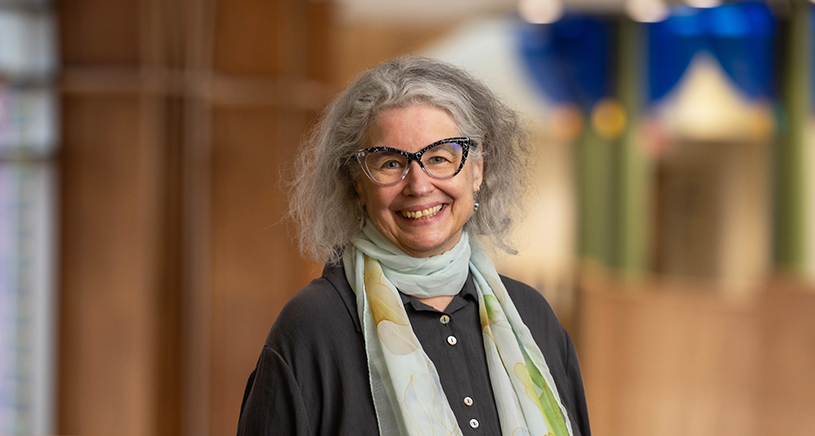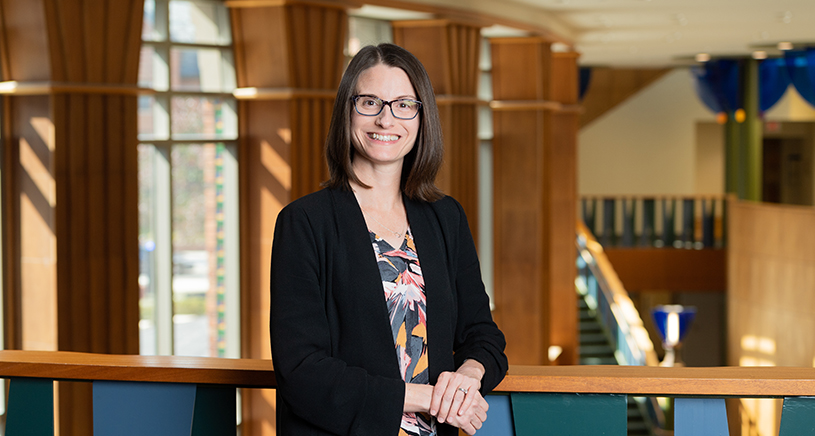How Bodies Weather Social Stress

When you hear the term “weathering,” you may think of soil or rock erosion next to a busy stream, or the paint of a house fading under the glare of the sun. But what if it could also happen to our bodies?
In this episode of Population Healthy Season 3: Race, Inequity, and Closing the Health Gap, experts from the University of Michigan School of Public Health discuss weathering, which encapsulates the idea that lived experiences and stress have impact on our bodily systems—with disadvantaged and/or populations of color often experiencing this firsthand. We’ll also learn about the ways researchers are studying the impacts of these social stressors—such as racism and discrimination—and how they can have an impact on your body at a cellular level.
Listen to "How Bodies Weather Social Stress" on Spreaker.
|
Subscribe and listen to Population Healthy on Apple Podcasts, Spotify, Google Podcasts, iHeartRadio, YouTube or wherever you listen to podcasts! Be sure to follow us at @umichsph on Twitter, Instagram, and Facebook, so you can share your perspectives on the issues we discussed, learn more from Michigan Public Health experts, and share episodes of the podcast with your friends on social media. |
0:04 Speaker 1: It's actually an interesting thing to know that these outside social factors could be impacting things at a cellular level. Something we can't even see with the human eye is being affected by these experiences of social exclusion and discrimination. It's really quite profound.
[music]
0:27 Narrator: When you hear the word weathering, you may think of soil or rock erosion next to a busy stream or the paint on a house fading under the glare of the sun, but you may not know that we have evidence that weathering is also something that happens to our bodies as people experience stress based on racial or other kinds of discrimination. Hello, and welcome to Population Healthy, a podcast produced by the University of Michigan School of Public Health. In this season of Population Healthy, we'll examine health inequities through the lens of race in America by talking to public health researchers, experts and others to learn more about what can be done to work toward health equity in our communities and across our country.
[music]
01:18 Narrator: In today's episode, we're focusing on weathering, a term coined by University of Michigan School of Public Health professor Arline Geronimus when she was a student at Princeton University in the 1970s. In essence, weathering is a term to describe socially-induced accelerated aging of your body. We'll dive into what is actually happening inside a person's body when weathering occurs and the reasons why certain populations are more susceptible to weathering.
01:43 Arline Geronimus: I first began to think about what I would come to call weathering when I was in college in the mid-1970s. I worked part-time at a school and clinic for pregnant teenagers in Trenton, New Jersey, which was a working class city with a large population of color, and I noticed that the teenagers in Trenton suffered from chronic health conditions that were unheard of in my generally better-off and less-diverse group of Princeton classmates of about the same age, but no one was talking about this. In fact, the conventional wisdom at that time was at late teen years and early 20s were the beginning of the health prime of life, and that chronic diseases didn't develop until middle age. I began to wonder both what accounted for this early health deterioration among the young women in Trenton, relative to Princeton, and whether that might be linked to the earlier childbearing of the Trenton teens.
In graduate school, I focused on the relationship between maternal age and adverse birth outcomes, and I found that, in contrast to accepted beliefs that there are universally-healthier and less-healthy ages to bear children from a reproductive health and maturity standpoint, that different populations within the United States, such as by racial, ethnic group or poverty status, or urban or rural or suburban residents had different trajectories for infant mortality and other adverse birth outcomes. In particular, the lowest risk ages for infant mortality in working-class populations of color were in the teens, and then risk increased linearly with maternal age after that. Yet, for Whites, on average, the teens were the highest risk ages for infant mortality and the lowest were in the mid to late-20s. Two other findings of note at that time were that Black mothers of any age were far more likely to experience poor birth outcomes than White, with the size of that inequity being lowest in the teens, and that, in any group I studied, the lowest risk ages, whether they be in the teens or 20s were the ages when most women in that group began child-bearing.
03:47 Geronimus: This led me to wonder whether fertility timing patterns were responsive to the inequities and healthy life expectancy in different populations, and the extent to which variation in healthy life expectancy was affected by structurally-patterned social experiences associated with race and poverty or other types of social disadvantage. Today, the idea that there are social determinants of health is widely-accepted, and studies of it abound, but at the time I did my dissertation, that was not true, and the mainstream public health idea was we should focus on individual behavioral risk factors and how to change them. Instead, I wondered whether it might be more fruitful to think about the high effort coping it required on the part of marginalized populations to sustain their family economies and caretaking systems in the face of uncertain health, housing and employment. That's when I began to call this new hypothesis weathering, in light of the fact that weathering seemed an apt contranym to encapsulate it.
I chose weathering to evoke a sense of biologic erosion by facing chronic and toxic stressors, but also, importantly, to emphasize the ways that marginalized groups subject to such chronic stressors collectively and tenaciously coped with the constant drumbeat of these stressors and their effects on their health in their daily round. Weathering is a structurally-rooted biopsychosocial process reflective of how life circumstances and experiences promote or undermine health on a population level as individuals grow in age. So, in this framework, people's health reflects the cumulative impact of their lived experiences, at least from conception to their current age. The older they are, the more time they've had to have health-impacting experiences and the greater the opportunity for these experiences to express any health effects or to accumulate or interact with others. In other words, when comparing the health of more and less privileged groups, 20 does not equal 20, 30 is even less likely to equal 30, and so on.
05:56 Narrator: New technologies over the last few decades allowed researchers to demonstrate the impacts of weathering. Researchers can now look at the biological effects through concepts like epigenetics or how genes respond based on behaviors and environment, and allostatic load, the wear and tear on your body due to chronic or repeated stress.
06:14 Geronimus: Early research established that members of oppressed populations suffered earlier onset and generally different age trajectories of stress-related conditions and diseases such as hypertension, diabetes and higher-circulating blood lead levels and environmental toxin. More recently, we have begun to study weathering at the molecular level. We also have growing evidence that indicators of cellular aging, such as telomere length, are influenced by social circumstances, environmental exposures and stressful life experiences. Being chronically-stressed can literally accelerate the aging of your cells.
[music]
06:55 Narrator: Scientists also look to telomere length as a measure of accelerated aging. To learn more about this, we spoke with Belinda Needham, an associate professor of Epidemiology at the University of Michigan School of Public Health.
07:07 Belinda Needham: Telomeres are the caps at the ends of chromosomes, and they get shorter as we age, they also get shorter with exposure to oxidative stress and to psychosocial stress, and shorter telomeres are then related to a lot of different adverse physical health outcomes, particularly cardiovascular disease and to mortality. I've done work, looking at the relationship between social status, psychosocial stressors, telomere length, and then disease and mortality. I think that's a really intriguing hypothesis, that the stress associated with social disadvantage results in accelerated biological aging, which then helps explain why people are more likely to develop chronic age-related diseases earlier, and also to die at an earlier age.
07:53 Narrator: This leads us to Enrique Neblett, a professor of Health Behavior and Health Education at the University of Michigan School of Public Health. He's one of the nation's leading scholars on racism and health. His research looks to understand how racism-related stress influences the mental and physical health of young African American people.
08:10 Enrique Neblett: I think one of the first times I learned about the epigenetic impacts of stress was actually as a graduate student here at the University of Michigan, and it actually planted the seed for me to go on and look at the effects of stress on the body. I went on to Howard to look at racism stress and how it relates to changes in cardiovascular function. So I do remember the first time that I started thinking about that when I saw some of the profound impacts of stress on health disparities, and I wanted to understand a little bit more about how that happened, how that worked. One of the things that seems somewhat obvious is that stress could adversely impact health and that could lead to things like a shorter life and increased disease, but at that point, when these conversations were just beginning, there wasn't a whole lot of empirical research to actually demonstrate that that was the case. It was many years later that folks started to talk about telomere length as a possible mechanism by which the impacts of stress could lead to some of the disparities that we see later on in life, and I became really interested in that work, so a couple of years ago, with one of my students, we posed a paper looking at the experience of discrimination and telomere length.
And in that paper, what we found was that high discrimination experiences were associated with a shorter telomere length, even after you controlled for stress and age and other sorts of things that might play a role. And what that research suggested is that discrimination experiences could accelerate biological aging in older African American males and females, which obviously was a pretty striking finding, in terms of thinking about how discrimination generates greater disease vulnerability and premature death, and also was consistent with some findings that other researchers were publishing at the time, linking discrimination and other types of stressors to telomere length.
10:26 Narrator: As we understand more and more about the effects of stress-related weathering on our body systems, we can look at the most effective ways of addressing weathering, both to help heal those who've already suffered significant stress and to prevent others from experiencing the ongoing negative effects of racial discrimination and other stressors that disproportionately impacts communities of color.
10:48 Geronimus: For those who have already weathered, we need greater access to healthcare and structurally-competent healthcare. There are many ways to address this, including moving forward toward universal health insurance and also addressing the fact of implicit bias among healthcare professionals that may lead them to not take the concerns of mothers in or shortly after childbirth seriously or treat patients of color equitably with other patients when presenting with symptoms of chronic disease. Fundamentally, we need to invest in people and places to expunge the chronic stressors, whether they be environmental, material or psychosocial, to which some populations are exposed, and to which they need to work tenaciously to overcome. We need to apply guiding principles based on growing knowledge of weathering to avoid policies that may be well-meaning, but in fact, may even exacerbate weathering in practice. There's every reason to believe that poor housing conditions, long commutes, threats of eviction, loss and fragmation of social support networks will add to the chronic stressors of those in oppressed communities and intensify their weathering.
[music]
12:05 Narrator: On the next edition of Population Healthy...
12:07 Speaker: I simply believe that every child deserves to breathe clean air, to drink safe and healthy water, to live in neighborhoods where playgrounds are free from lead, be able to attend schools where their asthma is not treated in the school buildings, and that shouldn't be based on race and income and zip code.
[music]
12:28 Narrator: Thanks for listening to this episode of Population Healthy: Race, Inequity and Closing the Health Gap, from the University of Michigan School of Public Health. We hope you learn something that will help you make the world a healthier place. Please subscribe or follow our Podcast on Apple Podcast, Google Play, Stitcher, Spotify, or wherever you listen to podcasts. Interested in studying public health with us? Join our interest list by going to our homepage, publichealth.umich.edu, and check out our programs and degrees, and other helpful resources across our website. Be sure to follow us @umichsph on Twitter, Instagram and Facebook to join the conversation, learn more from Michigan Public Health experts and share episodes of the podcast with your friends and followers. You can also check out the show notes on our website, publichealth.umich.edu/podcast for more resources about the topics discussed in this episode.
If you wanna stay up-to-date with the latest research and expertise from Michigan Public Health, subscribe to our weekly newsletter, Population Healthy. Head to publichealth.umich.edu/news/newsletter to sign up, and be sure to join us next time. Thanks for listening and doing your part to make the world a healthier place for all.
In This Episode
 Arline Geronimus
Arline Geronimus
Professor, Health Behavior and Health Education
Arline Geronimus is a professor of Health Behavior and Health Education at the University
of Michigan School of Public Health. Learn more.
 Enrique Neblett
Enrique Neblett
Professor, Health Behavior and Health Education
Enrique Neblett is a professor of Health Behavior and Health Education at the University
of Michigan School of Public Health and associate director of the Detroit Community-Academic Urban Research Center. Learn more.
 Belinda Needham
Belinda Needham
Associate Professor, Epidemiology
Belinda Needham is an associate professor of Epidemiology at the University of Michigan School of Public Health and co-director of the Center for Social Epidemiology and Population Health. Learn more.
